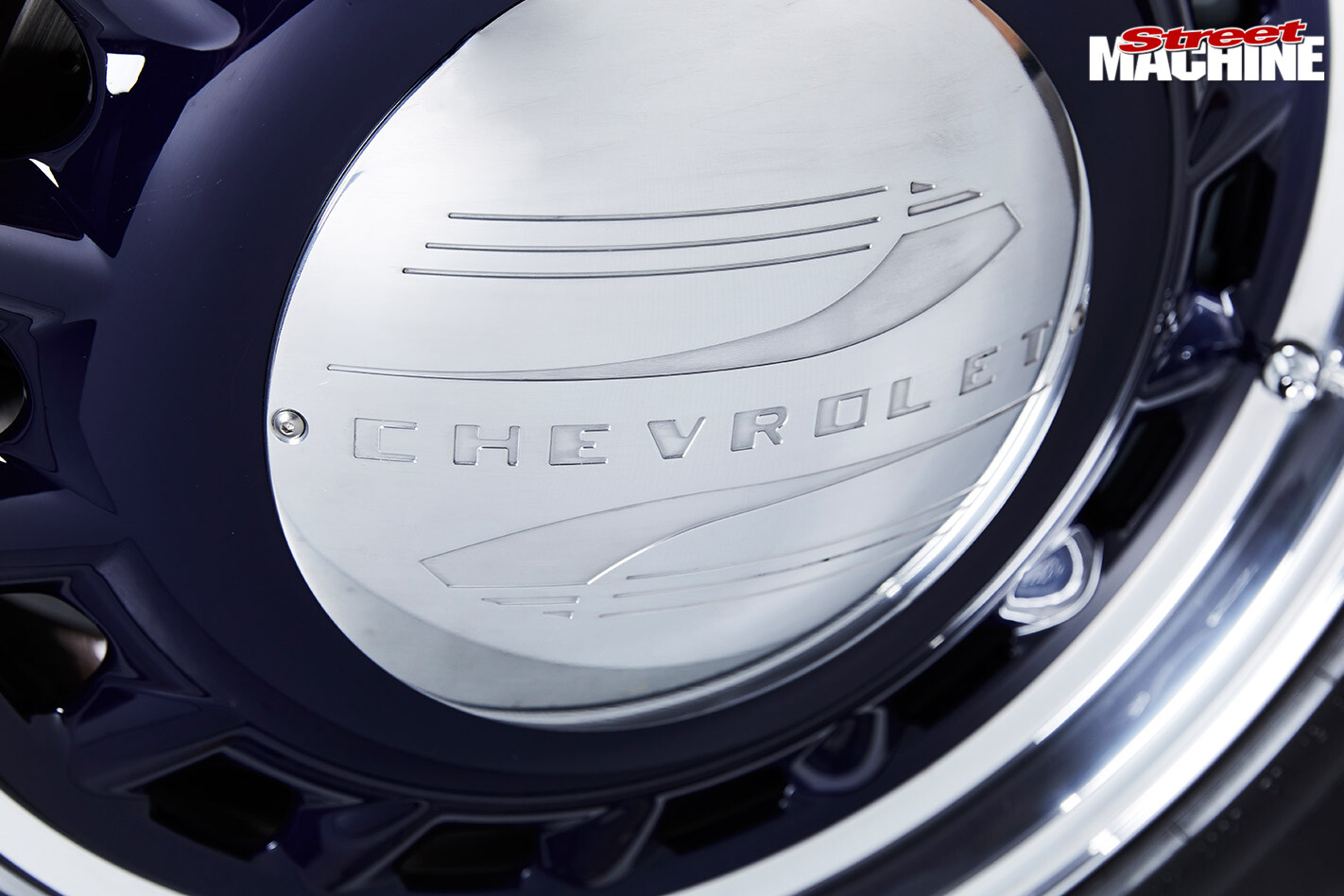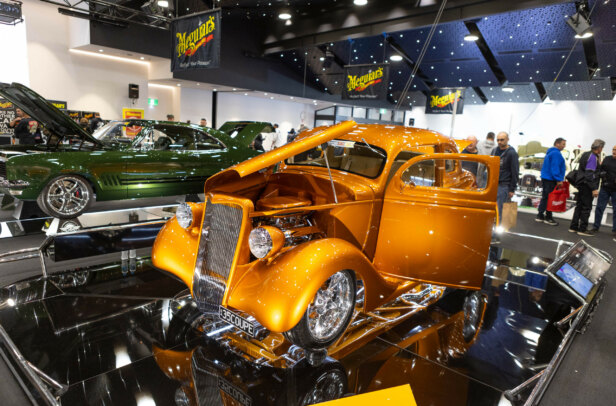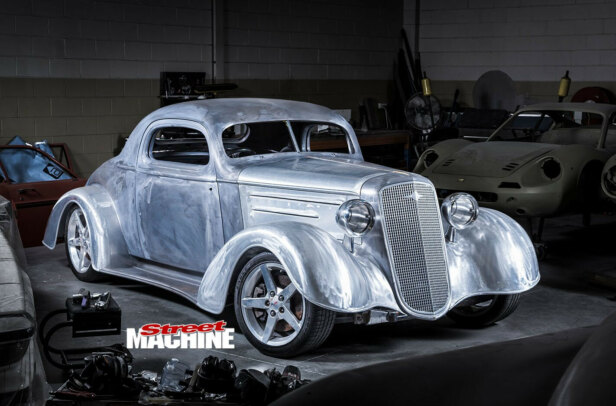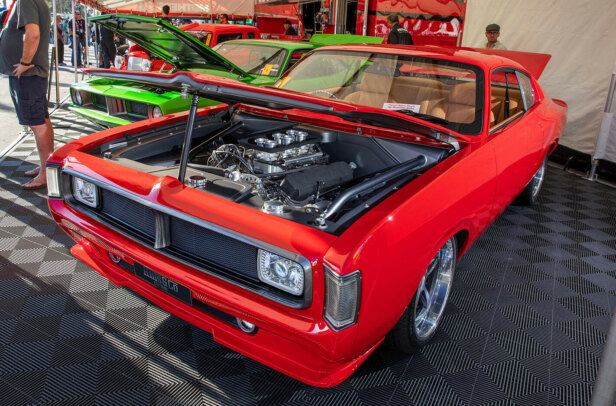THIS stunning ’35 Chevy coupe is what happens when the owner has complete trust in who they’ve chosen to build the car for them. Now, we’re not going to get into the whole ‘built not bought’ argument here, because the two people we’re talking about are deadset legends in the car scene.
The car’s profile hasn’t been changed too drastically, but the roof did come down 50mm and was reshaped to flow more smoothly into the deck lid. The quarter windows were also deleted and electric windows fitted
The builder doesn’t really need too much introduction to regular SM readers: it’s Peter Fitzpatrick, SMOTY winner and multiple Summernats Grand Champion, so we know that he can put a car together.
The low and squat stance is courtesy of the C6 Corvette underpinnings, which widens the track considerably. The fenders were remade in aluminium to cover the 245/40 and 275/40 rubber on 18×8 and 18×10 rims
The other bloke is Kees Weel. You may not have heard of him, but you’ve probably heard of Paul Weel, his son, and their business Paul Weel Radiators, aka PWR. Kees is a car guy through and through, with a pretty decent collection of cool rides, but he does like to drive them – show ponies aren’t his thing. And when Kees first spotted this Chev, it was far from a show pony.
The entire grille took 68 hours to CNC-machine over the course of three weekends so as not to interrupt PWR’s main business. It would have been easier to delete the badge, but Fitzy insisted they recreate that as well
“I bought it out of a wrecking yard in Gunnedah in northern NSW,” Kees says. “It was just sitting in the yard and I drove past and saw it. Because it was right-hand drive, I got a bit of an inkling that it was something special.”
The tail-light housings are custom-machined to accept the off-the-shelf indicator and brake-light lenses
That was around 2003-4, and the car sat around for a number of years gathering dust before Kees approached Fitzy about doing the build. “We were at MotorEx in 2014 and Kees asked me if I would build the car for him,” Fitzy says. “He said: ‘You know the one,’ and I said: ‘Yeah, the one I wanted to buy off you.’ I saw it up at his factory on the Gold Coast and I thought it would look shit-hot with a set of Center Lines, painted black with an LS in it.”

The wheels, including the hubcaps, were machined by Ryan and the team at PWR on the company’s five-axis CNC machine to mimic the original artillery-style wheels. The centres were painstakingly masked up and painted in the same blue as the body
Kees then asked the obvious question: “Do you have an idea of what it will cost?” To which Fitzy replied: “Nup, how good do you want it?” That would normally be a pretty open-ended question, but with Fitzy you’ve got some pretty good material you can reference. “Kees said to me: ‘If it’s as good as your ’34 Ford I’ll be happy, but I don’t want it anything like the FC.’ My next question was: ‘Do I get the use of the five-axis CNC?’”
A Glide seat was heavily modified and reshaped to add extra lumbar and lateral support. It was then expertly trimmed in distressed leather by Mick Carter from Mick’s Custom Interiors
Of course, the answer was yes, and as a result, there is quite a bit of custom-machined billet on the car, although you wouldn’t know to look at it. All of the CNC work was carried out by Ryan and the team at PWR.
The steering wheel is a billet creation inspired by the original three-spoke tiller
It’s pretty obvious Fitzy’s initial plans of a down-and-dirty hot rod got thrown out the window for a build that involved changing practically everything on the car yet still manages to be very sympathetic to the original styling. Even the paint colours were inspired by the duco that the Chev originally left the factory with, but this particular blue is a custom colour that Fitzy developed with Tony Naughton from PPG. “The black is a straight tinter, but for the blue I said: ‘I need a nice clean blue; make it for me, Tony,’” Fitzy says.
The gorgeous woodgrain finish on the dash looks just like real walnut, because it is. Created by furniture maker Peter Bollington of Curious Tales, it’s been beautifully shaped to accommodate the Auto Meter Prestige Antique Ivory gauges. He also shaped the walnut inlays on the doors
The choice of an LS2 powerplant is no massive surprise, but it’s what’s connected to it that is a bit different from most hot rod builds. “I bought a 2006 Corvette chassis and running gear out of the States; it was like brand new,” Kees says. “We measured it up and figured we could make it work under the ’35, but we did have to widen the guards, and made the chassis from the ground up to make sure we could fit all the suspension from the Corvette. As we got along the road a bit, we said: ‘Oh well, if we’re going to do this, let’s do that,’ and as you know things get more expensive as you go. We just figured we would do it once and do it properly.”
The glovebox hides the retro-styled stereo and Vintage Air a/c controls, and still leaves enough room for, well, a pair of gloves
For the chassis, Fitzy turned to Paul Sant at ProFlo Performance, who masterfully blended the Corvette suspension into the boxed chassis rails before tying it all together with tubular crossmembers. The chassis was then sent to Capital Precision Coating to be powdercoated satin-black, while the engine and driveline were painted in a pale grey for a period look.
The six-litre LS2 would have worked just fine with the factory intake and injection but would’ve been a bit of a letdown when you opened the bonnet, so Fitzy combined the best of both worlds: the tuneability of EFI with the rugged good looks of a Rochester 2G Tri-Power set-up. “Autotrend EFI in the States did the throttlebodies and it won Best New Product at SEMA a few years ago,” Fitzy explains. “I sent Kees a photo and said: ‘Man, look at these!’ We were talking about a supercharger, but it wasn’t the right thing for this car, so when he saw these he said: ‘Yeah, they’re cool; let’s go for that.’”
Fitzy looks over the chassis one last time before he has to hide it under the body. The chassis was designed off the original and modified to accommodate the C6 Corvette suspension and driveline
Of course, you can’t get EFI working without a bit of electronic wizardry, so a Holley Dominator ECU got the nod and Mark Sant from Ontrak Auto Electrical was called in to wire up the car.
The next issue was getting a Tri-Power intake to suit an LS, and there isn’t much out there, so Fitzy got the team at Custom Plenum Creations (CPC) in Wollongong on the job. They designed and machined a stunning two-piece billet intake to mount the triple TBs. With their hidden injectors and hard lines for fuel, you’d be hard-pressed to tell it’s a modern EFI system.
There’s an absolute mountain of work that has gone into the body as well. I mentioned the widened fenders earlier, but what I didn’t say is that they were fabricated from scratch by a coachbuilder out of aluminium. The rears are 70mm wider and the fronts 50mm on each side, which allows just enough room for the 18×8 and 18×10 rims with 245/40 and 275/40 rubber. The running boards were also made from scratch and reshaped with a curve to take away some of the visual weight. As the car wasn’t going to have bumpers, the bottom edge of the front guards was reshaped for a much cleaner look than factory.
One other very subtle touch that I didn’t even notice at first is the roof chop. It’s fairly mild at only 50mm, but the reason for it wasn’t to make the car look tougher – which is why most people chop hot rods – it was to clean up the lines and make them flow smoothly across the roof and down the deck lid. The bootlid was also redesigned to create a much larger opening and then remade in steel. The stunning paintjob was laid on by Trevor Davis Auto Refinishers in Dandenong.
The interior carries on the theme of modern functionality with original styling themes. A Glide seat was completely reshaped and then covered in distressed leather by Mick Carter from Mick’s Custom Interiors. The stitching pattern is simple, but they way Mick gets the leather so tight and the stitching so arrow-straight is why he’s regarded as one of the best in the business.
Many cars of this era featured a woodgrain finish on their dashboards, but Fitzy went the extra mile in that regard and brought in master furniture maker Peter Bollington of Curious Tales. He expertly sawed, carved, planed and sanded the dash and door inserts out of American walnut. The dash was then filled with Auto Meter Prestige Antique Ivory gauges.
As I write this, the car has just arrived in the USA, where it will be on display at the PWR stand at this year’s SEMA Show. It’s been entered in the Battle Of The Builders competition and will be the kind of car that lures people in for a closer look and showcases some amazing Aussie craftsmanship.
The end result of the build is testament to the long relationship that Kees and Fitzy have. “We’ve been using their gear for years,” Fitzy says. “I know Kees personally and I think he trusted me in looking after the build. Basically, he told me how he wanted it and I built it how I wanted it, if that makes sense. We didn’t try to make it look modern, but it does.”
THE CHASSIS
- The engine is a 6.0L LS2 that came out of the same Corvette that gave up its suspension. It only had 5000 miles on the clock, so all it needed was a makeover and a lumpy cam. The triple Rochester 2G carbs are actually EFI throttlebodies from Autotrend EFI
- The stunning CNC-machined intake is from Custom Plenum Creations in Wollongong and features the three-leaf clover logo of Fitzpatrick Speed Works. The oil fill tube is a throwback to the very earliest of small-block Chevs
- Corvettes run a transaxle, which moves the transmission to the rear of the car for near-perfect 50-50 weight balance. It also has the added benefit of freeing up space in the passenger footwell
- The rocker covers were machined by PWR to look like old tin covers. The block-letter Chevrolet logo was matched to hubcaps
KEES WEEL
1935 CHEVROLET SPORT COUPE
Paint: PPG Custom Blue, black tinter
ENGINE
Type: LS2 6.0L
Inlet: Custom Plenum Creations
Induction: Autotrend EFI-2G Tri-Power
ECU: Holley Dominator
Cam: Camtech
Radiator: PWR billet tanks
Exhaust: Headers 17/8in primaries, twin 3in stainless exhaust
Ignition: Stock
SHIFT
’Box: 4L65E auto transaxle
Converter: TCE 2800rpm stall
BENEATH
Front end: C6 Corvette
Rear end: C6 Corvette
Shocks: Lovells coil-overs
Steering: C6 Corvette
Brakes: C6 Corvette
ROLLING STOCK
Rims: Custom billet; 18×8 (f), 18×10 (r)
Rubber: Pirelli Dragon Sport 245/40R18 (f), Pirelli Cinturato P7 275/40R18 (r)



Comments